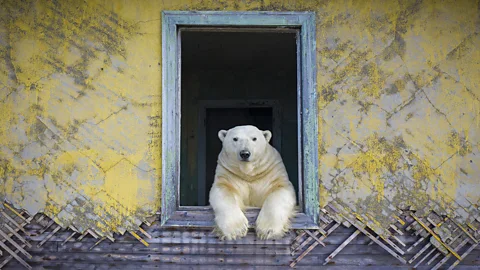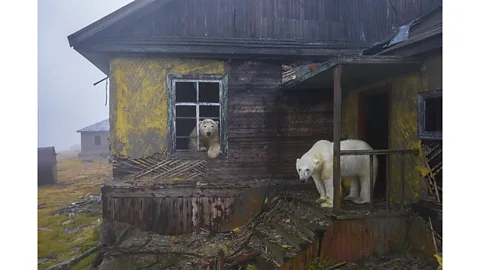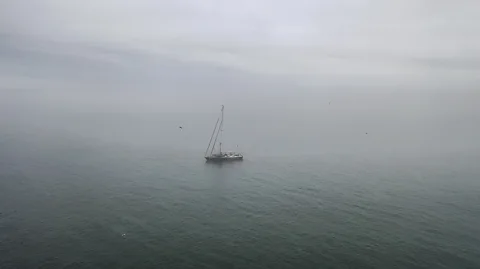The polar bears living in an abandoned Arctic weather station
 Dmitry Kokh
Dmitry KokhA photographer's iconic shot of polar bears in abandoned buildings on a Russian island shines a spotlight on wider changes in their behaviour.
In September 2021, Russian wildlife photographer Dmitry Kokh and his team were sailing around the wild and remote Chukotka Peninsula in Russia's extreme northeast. They were hoping to visit Wrangel Island, a well-known gathering place for polar bears, when the weather turned.
"We faced a heavy storm, with super-strong wind and waves, and we tried to find a place to shelter from the storm because the boat was small," Kokh recalls. They sheltered near the rocky shore of a small, uninhabited island called Kolyuchin, home to an abandoned Soviet-era weather station – and made an unexpected discovery.
"We saw some movement on the island, took out our binoculars, and saw polar bears roaming around there, many of them, maybe 15 or 20," Kokh says. "We were super surprised because we never expected to meet polar bears so far to the south. At this time of the year, they should be on the sea ice already, and on Wrangel Island, normally."
The weather station on Kolyuchin had been abandoned in the early 1990s, after the collapse of the Soviet Union. Stepping on the island to take pictures of the bears was too dangerous. Instead, Kokh used a drone, taking his time to get the bears used to it, then slowly flying it closer. As he was watching them, he noticed something else: there were bears inside some of the houses.
"I realised that it was a perfect setting for photography, because these houses are super photogenic, they are old and ruined, and animals looking out of these houses, is a perfect picture," he says. "And the weather was terrible, [there was] wind and rain and fog, which is also very good for photography! So everything came together."
One of the photos captures a bear in the entrance to the weather station, and another one looking out of the window. Titled "House of Bears", it won Kokh the prestigious Wildlife Photographer of the Year award, given out annually by the Natural History Museum in London. "It's the best picture I've ever taken, and I think I won't be able to repeat it, ever," he says.
Tom Smith, a professor of wildlife sciences at Brigham Young University in Utah, has spent decades conducting field work among bears, including polar bears, and says it's not unusual to see polar bears in abandoned buildings. "They're curious animals so we see them in structures often, or they will be climbing on top of cars or pipelines," he explains. There has, however, been a more worrying trend across the Arctic, he says: as the sea ice melts, polar bears are increasingly approaching or wandering into inhabited towns or villages, to feed on open rubbish dumps. "They are fatefully drawn towards human settlements," says Smith, and this can result in conflict with humans.
The problem is two-fold, according to Smith. One is that isolated, northern communities often use open rubbish pits near the village. Securing garbage so it can't be accessed, for example in bear-proof bins and enclosed landfills, is expensive, he points out – and in the past, was not necessary. "The overwhelming Western influence in the north has resulted in [throwaway] economies that never existed there," he says. "Those cultures never had a throwaway society, so the notion of having to secure garbage – that's a new thing."
 Dmitry Kokh
Dmitry KokhSecondly, Smith notes that polar bears are spending more time on land due to the climate-change-driven loss of sea ice. They are also shifting their dens from the ice onto the land, to avoid the risk of denning on the increasingly unstable sea ice, research in northern Alaska shows. Without the sea ice, the bears can't hunt for their preferred, ideal diet of blubber-rich seals, and may resort to land-based food, be it prey or rubbish.
"So we have a prediction that more and more bears are coming onto the land, they are increasingly hungry and drawn to these pits," Smith says. The rubbish pits tend to be close to the villages. "Because of that, we can expect more and more conflict with bears," he warns.
He emphasises that polar bear attacks on humans are very rare. According to one study, across more than a century, from 1870 to 2014, there were only 73 attacks by wild polar bears on humans, distributed among the five countries with polar bears: Canada, Greenland, Norway, Russia and the United States. Twenty of the attacks were deadly, and 63 caused injuries. (Because the attacks often involved more than one person, the total number of deaths and injuries is higher than the number of attacks.) Smith says that humans are not part of bears' natural diet – in contrast to big cats such as tigers and lions, who do see humans as potential food. "That is a global myth, that [polar bears] are the only bear that stalks and kills humans," he says.
Nevertheless, there have been cases where polar bears have attacked people, with malnourished male bears most likely to pose a threat to humans. In some cases, starving polar bears who have become used to human-provided food may then see humans as prey, research suggests. Smith says it's the increasing proximity to humans that's the problem, rather than the bears hunting humans as such: "The [bears] are there for the garbage, and then they will spin off into the village and of course they're quite capable of ripping doors and windows off. So we've seen an uptick in these confrontations," he says.
A 2022 research paper warns that food from human sources – especially waste – is an emerging threat to polar bears. The supply of such human-provided food including from dumps is growing, according to the paper. As a consequence, some communities in the Arctic have seen startling incursions of dozens of polar bears. The study notes that when given the choice between sea ice, and rubbish dumps on land, polar bears still prefer the sea ice – suggesting that they are resorting to the dumps out of necessity.
For example, in 2019, 60 polar bears gathered at a dump near the village of Ryrkaypiy in the Chukotka region of Russia, a few 100 metres from the village, according to the study. The bears also entered the village, causing alarm, and forcing the villagers to cancel public events and keep their children at home. However, once the sea ice formed and thickened, the polar bears left the land and returned to the sea.
In Novaya Zemlya, a remote Russian archipelago, a similar invasion of 52 polar bears happened in 2019, according to the study. "Although polar bears had visited the dump in previous years, this event was unprecedented," the researchers note, and was likely due to the loss of sea ice. In Arviat, an Inuit community in Nunavut, Canada, the number of polar bears using the local open dump has grown each year since record keeping began in the 1960s.
 Dmitry Kokh
Dmitry KokhSpending more time on land could threaten the bears' long-term survival, Smith says, as the marine diet is more suited to them. In particular, the high fat content of their preferred prey, seals, is crucial for their health. Fat, in the form of seal blubber, makes up around 70% of polar bears' natural diet on the sea ice. It contains twice the energy per gramme as muscle. In fact, when catching a seal, the bears mostly eat the blubber and leave the meat behind. To capture seals, the bears need sea ice – they stalk the seals on the ice, or wait by breathing holes in the ice for seals to appear. Over the past 50 years, as the sea ice has shrunk, the number of polar bears has fallen, studies show.
"They're using [the fat from the seal] for everything: growth, maintenance, reproduction, keeping their body warm," says Smith. "They just need a seal and some water and they're fine. They're unusual animals," he adds. They can subsist on this high-fat, seal-based diet without suffering any nutritional deficits, he says: "It's a metabolic marvel".
When they can't access seals and instead resort to less fatty prey on land, such as Arctic birds, bird eggs, or food from dumps, the bears' health and reproduction rates decline, and they risk starvation, studies suggest. Polar bears on land lose around one kilogramme of body mass a day, research shows.
"Part of the problem we have with climate change is the scale of change is so rapid," says Smith. There's not enough time for the highly specialised polar bears, who evolved to thrive on a diet of marine mammals, to adapt to permanently being on land again, he warns: "We're fearful this animal can't possibly adapt back to a land-based, herbivorous diet." If they had to be on land constantly, "as a species, they would die", he says.
Smith and other researchers are appealing to governments to provide funding to help secure rubbish dumps near coastal villages from bears. "It's extremely expensive. They need help. It wouldn't be asking too much to secure the garbage and make it safer for people, and for bears," he says. Otherwise, people confronted with growing numbers of bears in their villages may kill them to stay safe, he warns: "It is extremely unfortunate to see bears die from such a preventable cause [as unsecured garbage]."
In the town of Churchill, Canada, closing an open dump, along with other measures, decreased damage and human injury. Smith and his colleagues are also studying a range of additional steps to help communities co-exist with polar bears, such as bear spray.
While the real-life human-bear conflict is playing out, humans around the world still love seeing polar bears in pictures, the reaction to Kokh's photos suggests. In a video call, he shows a wealth of artwork and even tattoos which people made as the photos went viral.
"This was an absolutely crazy time, because I got so many emails and interview requests, and many people were talking to me about these images. And they were saying something like: 'this is a post-apocalyptic picture, this is how our planet will look like if we continue to do the same things with the planet and won't change our ways'," he says.
For Kokh, the award-winning photos of the polar bears opened many doors, and he has been on other expeditions to take photos of many kinds of marine wildlife. But as he reflects on that storm-swept journey to Chukotka, he comes back to the relationship between people and polar bears. For a start, even in that incredibly remote, wild region, you come across human rubbish, he says: "What you see in this area of Russian Arctic, it's abandoned barrels, fuel barrels. It's a commonly known problem because in the Soviet Union they brought thousands of fuel barrels and abandoned them, because it was expensive to bring them back. And they still lie there, and polar bears are roaming around them." In the photo series of the abandoned weather station, for example, there is a shot of the bears standing in a landscape of scattered barrels.
But Kokh also points out that the images can be interpreted in different ways – as a warning about our impact on the planet, but also, as testimony to the power and resilience of nature.
"When I was taking the picture, I was thinking about the striking contrast between the living animals, and these destroyed buildings," he says, and holds up a bottle, and a cup: "You know, all the things we make – this bottle, this cup – all the things made by humans, will be destroyed one day and will cease to exist, if we don't continue to make them. If humanity will fail, nothing will remain of us. But life will still exist."
--
For essential climate news and hopeful developments to your inbox, sign up to the Future Earth newsletter, while The Essential List delivers a handpicked selection of features and insights twice a week.
